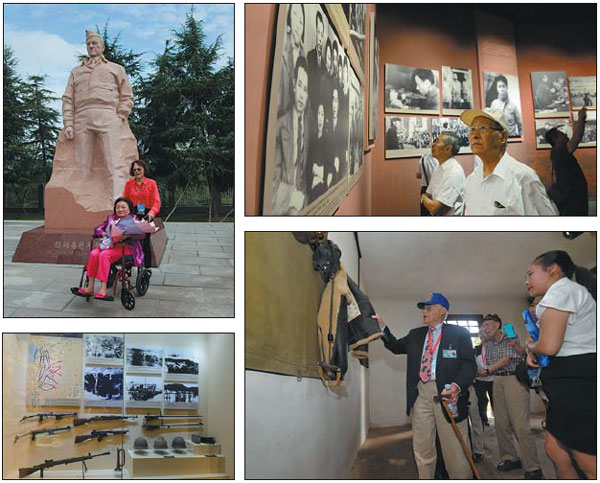The poignant place where Japan accepted defeat
|
Top left: Anna Chan Chennault, widow of the Flying Tiger's leader General Claire Chennault, is photographed next to a statue of her late husband in front of the Flying Tiger Memorial Museum. Above left: Some of the exhibits on display at the Zhijiang Memorial Hall of the Victory over Japan. Top right: Visitors look at old photos at the hall. Photos Provided to China Daily Above right: Flying Tiger veteran Paul Crawford visits the Flying Tiger museum. Xinhua |
Ideally, the story of Japan's surrender in the Zhijiang Dong autonomous region, Huaihua city, Hunan province, should be told from a small structure called Qili Bridge.
Qili is the Chinese term for a distance of 3.5 kilometers, and the bridge is located about the same distance from the county center. The bridgehead carries a stone tablet that bears a carved inscription: "The site of the Japanese military surrender".
The surrounding area was once the headquarters of the air force of the Republic of China, and after the Japanese capitulation in August 1945, the central government chose it as the site of Japan's formal surrender on Aug 21.
A tall, white granite arch erected in the grounds of the Zhijiang Memorial Hall of the Victory over Japan is the best example of that triumph. Built in 1946, the arch is the only piece of architecture in China built specifically to commemorate the country's victory in the War of Resistance against Japanese Aggression (1937-45) and World War II.
Rows of black wooden houses stand, hidden behind a row of trees, about 50 meters from the arch. Seven decades have passed, but the room in which the surrender document was signed has been well preserved and all the artifacts have been maintained in their original conditions.
Takeo Imai, vice-chief of the general of Japan's China Expeditionary Army, led the eight-strong Japanese delegation at the signing ceremony. Some of the photos taken at the ceremony are displayed at the memorial hall, and one of them shows the Japanese delegation wiping away beads of sweat and wearing subdued expressions.
During the ceremony the Japanese delegates handed over maps showing the deployment of the Japanese army in China, and received detailed instructions about the 16 regions that would surrender and the locations of 100 sites where soldiers were obliged to hand over their weapons.
Those wondering why such an important ceremony was held in such a remote location can find the answer at the Flying Tigers Memorial, which stands on the east side of Zhijiang Airport. The memorial's 1,460-square-meter grounds are designed to resemble two planes when seen from afar.
The memorial, which was built in 2005, contains a large number of relics and rare documents, and the site of the old control tower stands in the grounds. The memorial building has seven major exhibitions featuring photos, documents, film footage, weapons and some of the pilots' personal effects. The names of 2,000 US airmen have been carved on a black marble wall so they will live in history forever.
On Sept 5, Flying Tigers' veterans participating in the Fifth China Zhijiang International Peace and Culture Festival visited the memorial and laid down bouquets of flowers and saluted - their silence was a dignified and fitting farewell to their fallen comrades.
hena@chinadaily.com.cn

























